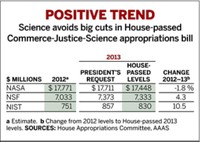Advertisement
Grab your lab coat. Let's get started
Welcome!
Welcome!
Create an account below to get 6 C&EN articles per month, receive newsletters and more - all free.
It seems this is your first time logging in online. Please enter the following information to continue.
As an ACS member you automatically get access to this site. All we need is few more details to create your reading experience.
Not you? Sign in with a different account.
Not you? Sign in with a different account.
ERROR 1
ERROR 1
ERROR 2
ERROR 2
ERROR 2
ERROR 2
ERROR 2
Password and Confirm password must match.
If you have an ACS member number, please enter it here so we can link this account to your membership. (optional)
ERROR 2
ACS values your privacy. By submitting your information, you are gaining access to C&EN and subscribing to our weekly newsletter. We use the information you provide to make your reading experience better, and we will never sell your data to third party members.
Policy
Good News For Science Budgets
House and Senate are on track to boost funds at several science agencies in 2010
by David J. Hanson
July 13, 2009
| A version of this story appeared in
Volume 87, Issue 28

After several years of fumbling the appropriations process, Congress is off to a better start this year. Among its timely actions, Congress is close to passing its first major 2010 funding bill for science and technology, with significant increases slated for research and education.
The House of Representatives has passed the Commerce, Justice, Science & Related Agencies (CJS) Appropriations Act for fiscal 2010 (H.R. 2847), which includes funding for the National Science Foundation, National Aeronautics & Space Administration, and the National Institute of Standards & Technology. Research funding at all of these agencies would go up. And the Senate Appropriations Committee has unanimously approved its version of the bill covering the same agencies, opening the way for a final vote by the full Senate.
Along with the Energy Department's Office of Science, the three science agencies have also benefited from additional funds from the American Recovery & Reinvestment Act (ARRA) and have congressional support for doubling their research budgets over the next 10 years as prescribed in the America Competes Act.
"The House and Senate CJS appropriations bills are mostly in line with the 2010 Administration request but with significant shortfalls in a couple of areas, mostly NASA's explorations programs, in the House version of the bill," says Kei Koizumi, the assistant director for federal R&D at the White House Office of Science & Technology Policy (OSTP). Although unable to comment directly on specific funding amounts in the bills, Koizumi says the bills have "welcome increases for science and education programs," which the Administration considers important parts of the agencies' missions.
The largest of the science agencies in these bills is NASA, and it is the most controversial. The NASA appropriation for fiscal 2009 is $17.8 billion, and the Obama Administration requested a 5.1% increase to $18.7 billion for 2010. The House-passed legislation cuts the request by about $500 million to $18.2 billion, for a 2.3%, or $400 million, increase above this year's appropriation.
The Senate Appropriations Committee approved the NASA budget for the full amount the President requested.
The primary difference between the House and Senate bills is funding for NASA's human space exploration program. The House voted to cut some of these funds, about $670 million, for next year in anticipation of recommendations from a newly appointed blue-ribbon review of the U.S.'s space flight options (C&EN, May 18, page 32). Norman R. Augustine, retired chairman and chief executive officer of Lockheed Martin, is chair of that panel, the Review of Human Space Flight Plans Committee. The report is expected to be available by August. Two years ago, Augustine led the National Academies commission that produced "Rising Above the Gathering Storm," the report on science and technology that inspired the America Competes Act.
In addressing criticism of the NASA cuts, Rep. Alan B. Mollohan (D-W.Va.), chair of the House Appropriations Subcommittee on CJS, emphasized that the House bill did not really reduce funding for space exploration, but merely "deferred" increasing the amount until the commission's report could be reviewed and the Obama Administration had a chance to establish its own plans.
The Senate, however, was concerned that such a large cut would have negative impacts on whatever options the Augustine review panel might present, including possible job losses and costly delays in mission programs, and it voted to keep nearly the full requested amount. An Obama Administration policy statement from the Office of Management & Budget echoes the Senate's opinion, saying, "The large reduction would likely cause major negative impacts to any options that may emerge from the ongoing blue-ribbon review of U.S. human space flight plans."
The House was more generous with NSF, voting to give the agency $6.9 billion in 2010, a 6.9%, or $446 million, increase over the $6.5 billion enacted for fiscal 2009. The Administration had sought only slightly more at $7.0 billion. The Senate committee approved a nearly identical amount.
Most of the difference between the President's request and what the House approved comes from cuts in NSF's research funding, according to the House Appropriations Committee's report on the bill. The House cut the Administration's $5.7 billion request for NSF's research and related activities by $91 million, or 1.6%, to $5.6 billion. Still, the amount is 8.9%, or $459 million, more than the 2009 funding. The cut from NSF was made "to enable increases in important research and education funding at the National Oceanic & Atmospheric Administration and NASA," the House report states. The Senate committee also set NSF's research funding below the President's request.
How to handle the huge bump in funds received by NSF and other science agencies from ARRA is a concern for both the House and the Senate. NSF received $3 billion from that bill and is using the funds to support new grants. The House wants to balance NSF funding during the next several years to sustain the expected rise in the scientific workforce created by the stimulus funds. This apparently means reducing research funds slightly this year in order to spend more in the ensuing years to support the jump in the number of researchers after the stimulus funds are spent.
The boom-and-bust issue needs to be carefully watched because the real test will be after 2011, OSTP's Koizumi points out. "I've been monitoring the recovery act spending plans of the science agencies, and they have gone to great lengths to ease the possibility of a post-recovery-act crash through policy measures such as staggered grant durations, use of administrative supplements, funding of backlogged construction projects, and one-time infrastructure and other awards," he tells C&EN. "There is only so much agencies can do right now, so we'll have to keep watching to see how the 2010 budgets are spent and what future budgets look like."
Members of Congress have expressed concern about the boom-and-bust problem, points out Albert H. Teich, director of science and policy programs for the American Association for the Advancement of Science (AAAS). "Everyone recognizes that there's a cliff ahead, but so far no one seems to have come up with a good idea for what to do when we reach it," he says.
To fund NIST, the House voted to spend $781 million for fiscal 2010, a cut of 4.6% from this year's funding of $819 million. The Administration had requested a 3.3% increase, to $846 million. The Senate committee, meanwhile, voted to approve more funds for NIST next year, setting the budget at $879 million, which is 7.3%, or $60 million, more than in 2009.
Funds for NIST scientific and technical research services, however, which include the agency's laboratories, will rise significantly in both bills. The House passed an 8.1% increase, or $38 million more for 2010, to $510 million. The Senate committee approved $10 million more than that, providing $520 million for next year.
NIST's Manufacturing Extension Partnership assistance program and the Technology Innovation Program for industrial grants are slated to receive identical funding next year from both the House and Senate. MEP will receive $125 million, an increase of 13.4%, or $14.7 million, and TIP will get $70 million, an increase of 7.5%, or $5 million, from the 2009 enacted appropriation.
The biggest difference between the two congressional measures for NIST is for facilities construction. For 2009, NIST received $172 million for construction, but Obama requested just $117 million for 2010. The House, however, cut NIST construction funds by $95 million, or 55%, to $77 million. This support will not allow any new project starts. The Senate committee also cut construction funds, but by only $8 million from 2009. Most of the rest of the Senate's increase to the NIST budget comes from $47 million in congressionally directed projects, or earmarks.
One area Congress is not skimping on is science education. Both NSF and NASA have large science education programs, and these will likely be bigger next year. At NSF, education programs would get a 2.1% increase from the House, for a total of $863 million, up $18 million from the 2009 level of $845 million. The Senate committee approved a slightly smaller $13 million rise, to $858 million, which is the amount the President proposed for 2010. These increases do not include the nearly $100 million NSF received for education under ARRA.
Funding of NASA's education programs is a little more complicated. Although the House voted to raise NASA's education funds from $169 million in 2009 by $5.8 million, or 3.4%, to $175 million for 2010, the Senate would trim the programs' funding somewhat, approving $140 million for next year, a reduction of 17%. The amount, however, is still more than the $126 million the President requested. The hope is that these programs will encourage more students to become scientists and engineers; a congressional task force determined that one-quarter of the U.S. aerospace workforce will be eligible to retire by the end of this year.
The Senate should pass its version of the CJS bill fairly soon, and except for NASA's human space exploration program, reconciling the science agency differences between the bills should be easy. "The Senate bill mirrors the bill passed by the House," AAAS's Teich says, "and the differences between the two bills and the Administration's request are minor." Because Obama seems to be getting pretty much what he asked for in the budget, the increases for next year's science funding look fairly certain.





Join the conversation
Contact the reporter
Submit a Letter to the Editor for publication
Engage with us on Twitter